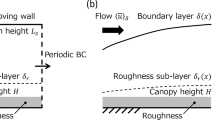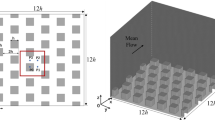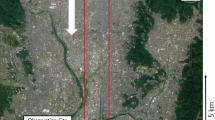Abstract
Large-eddy simulations (LES) are performed to simulate the atmospheric boundary-layer (ABL) flow through idealized urban canopies represented by uniform arrays of cubes in order to better understand atmospheric flow over rural-to-urban surface transitions. The LES framework is first validated with wind-tunnel experimental data. Good agreement between the simulation results and the experimental data are found for the vertical and spanwise profiles of the mean velocities and velocity standard deviations at different streamwise locations. Next, the model is used to simulate ABL flows over surface transitions from a flat homogeneous terrain to aligned and staggered arrays of cubes with height \(h\). For both configurations, five different frontal area densities \((\uplambda _\mathrm{f})\), equal to 0.028, 0.063, 0.111, 0.174 and 0.250, are considered. Within the arrays, the flow is found to adjust quickly and shows similar structure to the wake of the cubes after the second row of cubes. An internal boundary layer is identified above the cube arrays and found to have a similar depth in all different cases. At a downstream location where the flow immediately above the cube array is already adjusted to the surface, the spatially-averaged velocity is found to have a logarithmic profile in the vertical. The values of the displacement height are found to be quite insensitive to the canopy layout (aligned vs. staggered) and increase roughly from \(0.65h\) to \(0.9h\) as \(\uplambda _\mathrm{f}\) increases from 0.028 to 0.25. Relatively larger values of the aerodynamic roughness length \((z_0)\) are obtained for the staggered arrays, compared with the aligned cases, and a maximum value of \(z_0\) is found at \(\uplambda _\mathrm{f} = 0.111\) for both configurations. By explicitly calculating the drag exerted by the cubes on the flow and the drag coefficients of the cubes using our LES results, and comparing the results with existing theoretical expressions, we show that the larger values of \(z_0\) for the staggered arrays are related to the relatively larger drag coefficients of the cubes for that configuration compared with the aligned one. The effective mixing length \((l_\mathrm{m})\) within and above different cube arrays is also calculated and a local maximum of \(l_\mathrm{m}\) within the canopy is found in all the cases, with values ranging from \(0.2h\) to \(0.4h\). These patterns of \(l_\mathrm{m}\) are different from those used in existing urban canopy models.













Similar content being viewed by others
References
Abkar M, Porté-Agel F (2012) A new boundary condition for large-eddy simulation of boundary-layer flow over surface roughness transitions. J Turbul 13:1–18
Albertson JD, Parlange MB (1999) Surface length scales and shear stress: implications for land-atmosphere interaction over complex terrain. Water Resour Res 35:2121–2132
Belcher SE, Jerram N, Hunt JCR (2003) Adjustment of a turbulent boundary layer to a canopy of roughness elements. J Fluid Mech 488:369–398
Boppana VBL, Xie Z-T, Castro IP (2010) Large-eddy simulation of dispersion from surface sources in arrays of obstacles. Boundary-Layer Meteorol 135:433–454
Brown MJ, Lawson RE, DeCroix DS, Lee RL (2001) Comparison of centerline velocity measurements obtained around 2D and 3D building arrays in a wind tunnel. Tech. Rep, Los Alamos National Laboratory, NM, 7 pp
Businger JA, Wyngaard JC, Izumi Y, Bradley EF (1971) Flux–profile relationships in the atmospheric surface layer. J Atmos Sci 28:181–189
Canuto C, Hussaini MY, Quarteroni AM, Zang TA (1988) Spectral methods in fluid dynamics. Springer, New York 568 pp
Castillo MC, Inagaki A, Kanda M (2011) The effects of inner-and outer-layer turbulence in a convective boundary layer on the near-neutral inertial sublayer over an urban-like surface. Boundary-Layer Meteorol 140:453–469
Castro IP, Cheng H, Reynolds R (2006) Turbulence over urban-type roughness: deductions from wind-tunnel measurements. Boundary-Layer Meteorol 118:109–131
Chamorro LP, Porté-Agel F (2010) Wind-tunnel study of surface boundary conditions for large-eddy simulation of turbulent flow past a rough-to-smooth surface transition. J Turbul 11:1–17
Cheng H, Castro IP (2002a) Near-wall flow development after a step change in surface roughness. Boundary-Layer Meteorol 105:411–432
Cheng H, Castro IP (2002b) Near wall flow over urban-like roughness. Boundary-Layer Meteorol 104:229–259
Cheng H, Hayden P, Robins AG, Castro IP (2007) Flow over cube arrays of different packing densities. J Wind Eng Ind Aerodyn 95:715–740
Cheng W-C, Porté-Agel F (2013) Evaluation of subgrid-scale models in large-eddy simulation of flow past a two-dimensional block. Int J Heat Fluid Flow 44:301–311
Coceal O, Belcher SE (2004) A canopy model of mean winds through urban areas. Q J R Meteorol Soc 130:1349–1372
Coceal O, Belcher SE (2005) Mean winds through an inhomogeneous urban canopy. Boundary-Layer Meteorol 115:47–68
Coceal O, Thomas TG, Castro IP, Belcher SE (2006) Mean flow and turbulence statistics over groups of urban-like cubical obstacles. Boundary-Layer Meteorol 121:491–519
Coceal O, Dobre A, Thomas TG, Belcher SE (2007a) Structure of turbulent flow over regular arrays of cubical roughness. J Fluid Mech 589:375–409
Coceal O, Thomas TG, Belcher SE (2007b) Spatial variability of flow statistics within regular building arrays. Boundary-Layer Meteorol 125:537–552
Fang J, Diebold M, Higgins C, Parlange MB (2011) Towards oscillation-free implementation of the immersed boundary method with spectral-like methods. J Comput Phys 230:8179–8191
Grimmond CSB, Oke TR (1999) Aerodynamic properties of urban areas derived from analysis of surface form. J Appl Meteorol 38:1262–1292
Hinze JO (1975) Turbulence, 2nd edn. McGraw-Hill, New York, 790 pp
Kanda M (2006) Large-eddy simulations on the effects of surface geometry of building arrays on turbulent organized structures. Boundary-Layer Meteorol 118:151–168
Lu H, Porté-Agel F (2010) A modulated gradient model for large-eddy simulation: application to a neutral atmospheric boundary layer. Phys Fluids 22:015109
Macdonald RW (2000) Modelling the mean velocity profile in the urban canopy layer. Boundary-Layer Meteorol 97:25–45
Macdonald RW, Griffiths RF, Hall DJ (1998) An improved method for the estimation of surface roughness of obstacle arrays. Atmos Environ 32:1857–1864
Macdonald RW, Carter Schofield S, Slawson PR (2002) Physical modelling of urban roughness using arrays of regular roughness elements. Water Air Soil Pollut 2:541–554
Marusic I, Kunkel GJ, Porté-Agel F (2001) Experimental study of wall boundary conditions for large-eddy simulation. J Fluid Mech 446:309–320
Meneveau C, Katz J (2000) Scale-invariance and turbulence models for large-eddy simulation. Annu Rev Fluid Mech 32:1–32
Mittal R, Iaccarino G (2005) Immersed boundary methods. Annu Rev Fluid Mech 37:239–261
Orszag SA, Pao Y-H (1975) Numerical computation of turbulent shear flows. Adv Geophys 18 A:225–236
Pendergrass W, Aria SPS (1984) Dispersion in neutral boundary layer over a step change in surface roughness—I. Mean flow and turbulence structure. Atmos Environ 18:1267–1279
Perrier ER, Robertson JM, Millington RJ, Peter DB (1972) Spatial and temporal variation of wind above and within a soybean canopy. Agric Meteorol 10:421–442
Petersen RL (1997) A wind tunnel evaluation of methods for estimating surface roughness length at industral facilities. Atmos Environ 31(1):45–57
Pietri L, Petroff A, Amielh M, Anselmet F (2009) Turbulence characteristics within sparse and dense canopies. Environ Fluid Mech 9:297–320
Pope SB (2000) Turbulent flows. Cambridge University Press, Cambridge, 771 pp
Porté-Agel F (2004) A scale-dependent dynamic model for scalar transport in large-eddy simulations of the atmospheric boundary layer. Boundary-Layer Meteorol 112:81–105
Porté-Agel F, Meneveau C, Parlange MB (2000) A scale-dependent dynamic model for large-eddy simulation: application to a neutral atmospheric boundary layer. J Fluid Mech 415:261–284
Porté-Agel F, Wu YT, Lu H, Conzemius RJ (2011) Large-eddy simulation of atmospheric boundary layer flow through wind turbunes and wind farms. J Wind Eng Ind Aerodyn 99:154–168
Porté-Agel F, Wu YT, Chen CH (2013) A numerical study of the effects of wind direction on turbine wakes and power losses in a large wind farm. Energies 6:5297–5313
Raupach MR (1992) Drag and drag partition on rough surfaces. Boundary-Layer Meteorol 60:375–395
Raupach MR (1994) Simplified expressions for vegetation roughness length and zero-plane displacement as functions of canopy height and area index. Boundary-Layer Meteorol 71:211–216
Raupach MR, Thom AS, Edwards I (1980) A wind-tunnel study of turbulent flow close to regularly arrayed rough surfaces. Boundary-Layer Meteorol 18:373–397
Sagaut P (2006) Large eddy simulation for incompressible flows: an introduction, 3rd edn. Springer, Berlin, 558 pp
Savelyev SA, Taylor PA (2005) Internal boundary layers: I. Height formulae for neutral and diabatic flows. Boundary-Layer Meteorol 115:1–25
Schultz M, Schatzmann M, Leitl B (2005) Effect of roughness inhomogeneities on the development of the urban boundary layer. Int J Environ Pollut 25:105–117
Stoll R, Porté-Agel F (2006) Effect of roughness on surface boundary conditions for large-eddy simulation. Boundary-Layer Meteorol 118:169–187
Stoll R, Porté-Agel F (2008) Large-eddy simulation of the stable atmospheric boundary layer using dynamic models with different averaging schemes. Boundary-Layer Meteorol 126:1–28
Tseng Y-H, Meneveau C, Parlange MB (2006) Modeling flow around bluff bodies and predicting urban dispersion using large eddy simulation. Environ Sci Technol 40:2653–2662
Voller VR, Porté-Agel F (2002) Moore’s law and numerical modeling. J Comput Phys 179:698–703
Wan F, Porté-Agel F (2011) Large-eddy simulation of stably-stratified flow over a steep hill. Boundary-Layer Meteorol 138(3):367–384
Wieringa J (1993) Representative roughness parameters for homogeneous terrain. Boundary-Layer Meteorol 63:323–363
Wood DH (1982) Internal boundary-layer growth following a step change in surface roughness. Boundary-Layer Meteorol 22:241–244
Wu YT, Porté-Agel F (2011) Large-eddy simulation of wind-turbine wakes: evaluation of turbine parametrisations. Boundary-Layer Meteorol 138:345–366
Wu YT, Porté-Agel F (2012) Atmospheric turbulence effects on wind-turbine wakes: an LES study. Energies 5:5340–5362
Wu YT, Porté-Agel F (2013) Simulation of turbulent flow inside and above wind farms: model validation and layout effects. Boundary-Layer Meteorol 146:181–205
Xie Z-T, Coceal O, Castro IP (2008) Large-eddy simulation of flows over random urban-like obstacles. Boundary-Layer Meteorol 129:1–23
Acknowledgments
We gratefully acknowledge Michael J. Brown for kindly supplying the wind-tunnel data for our LES validation. This research was supported by the Swiss National Science Foundation (grant 200021-132122 and IZERZ0-142168) and the Swiss Innovation and Technology Committee (CTI) within the context of the Swiss Competence Center for Energy Research ’FURIES: Future Swiss Electrical Infrastructure’. Computing resources were provided by the Swiss National Supercomputing Centre (CSCS) under project ID s467.
Author information
Authors and Affiliations
Corresponding author
Rights and permissions
About this article
Cite this article
Cheng, WC., Porté-Agel, F. Adjustment of Turbulent Boundary-Layer Flow to Idealized Urban Surfaces: A Large-Eddy Simulation Study. Boundary-Layer Meteorol 155, 249–270 (2015). https://doi.org/10.1007/s10546-015-0004-1
Received:
Accepted:
Published:
Issue Date:
DOI: https://doi.org/10.1007/s10546-015-0004-1




